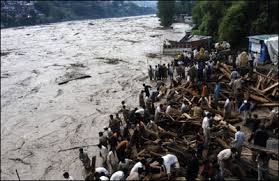LIFE REMAINS DISRUPTED IN JAMMU AND KASHMIR, GOVT NOT EQUAL TO THE MASSIVE TASKS AHEAD
J&K is battling the worst floods in a century

NEW DELHI: Its been weeks since the devastating floods that killed over 300 people and left tens of thousands homeless ravaged the state of Jammu and Kashmir. While the waters have receded and the floods abated, life remains totally disrupted for the lakhs impacted by the floods.
Over 305 people in the state are still untraceable, with the missing numbers being added to with every passing day. Officials also expect the death toll to increase as clear assessments have not been received from the remote villages, many of which were swept away in the torrential rain waters.
Officials said that among the missing people, many are residents of Srinagar, as well as laborers and tourists from the states of Uttar Pradesh and West Bengal. Many residents of different districts of Valley, who were trapped in Rajbagh, Jawahar Nagar and Bemina areas, have also not been traced yet.
The major threat at this stage is that of an epidemic and experts fear that cholera and other communicable diseases threat looms large as hundreds of carcasses of animals were still left unattended.
Medical practitioners have been urging the government to deal with the health crisis in an effective way and dispose-off animal carcasses on an immediate basis, but not much has been done by the government yet.
The government hasn’t been able to even de-water the residential and commercial areas of Srinagar city prompting the residents to flee their own homes.
Residents of submerged colonies in Mehjoor Nagar, Jawahar Nagar, Rajbagh, Bemina, Batmaloo and Nowgam said hundreds of livestock has perished in the flood. They feared that the carcasses will make it difficult to move in these areas once the water level recedes.
Scores of people from Tengpora, Batamaloo, Padshahi Bagh, Rajbagh, Jawahar Nagar and other localities are also shifting to rented accommodation after abandoning their homes where the water remained stagnated fearing that they might catch diseases.
Electricity and communication lines continue to remain one of the major issues. Although it is claimed that most of the connectivity has been restored, many still face a lot of problems due to the disrupted lines.
Coming to the destruction caused by the worst catastrophic floods in almost a century, the losses have been gigantic.
According to the government, more than two lakh structures were damaged, which included 20,000 houses totally destroyed. Further, losses to the agriculture sector in flood-ravaged Kashmir division including Ladakh region have been pegged at Rs 3,674 crores as crops on three lakh hectares of land have been damaged by the natural calamity.
Responding to a PIL which accused the government of not providing timely relief to the flood-affected people, filed by two advocates in the High Court, the government on Monday said “Approximately 2,34,516 structures have been damaged, which includes nearly 20,000 completely damaged houses, in the valley excluding district Srinagar. The damages to other houses and structures will be known only when the submerged areas are fully dewatered”.
Further, defending itself and denying the allegation, the government said that it had established 224 relief camps across the State including 137 in Kashmir Valley, adding that an amount of Rs 430 crore , Rs 215 crore each for Jammu and Valley regions – was kept the at the disposal of respective Divisional Commissioners for meeting exigencies like ex gratia relief and rehabilitation. .
Not only this, the Army also suffered enormous damage.
Seventy Army installations, including camps, bunkers and posts, have been hit by the devastating floods in Kashmir Valley. Further, two minor ammunition dumps were affected and small stores and other ammunition have suffered losses.
However,the security forces have swiftly relocated the damaged and washed out posts to plug the gaps in the sensitive border areas.
While the state government is carrying out loss assessment due to floods on a war footing in areas where water level has reduced, Chief Minister Omar Abdullah had said on Friday that the overall losses to all sectors would run into many thousand crores.



